1984 Detroit Grand Prix race report
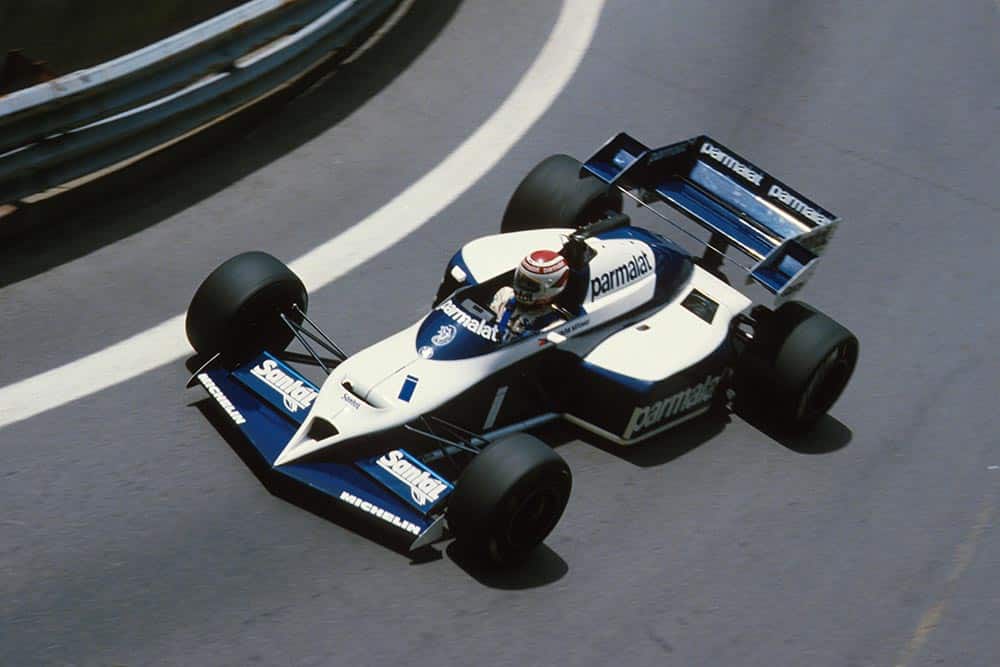
Nelson Piquet made it two wins in a row for Brabham
Motorsport Images
Nelson Piquet displayed the sort of unruffled superiority that has helped him win two World championships when he triumphed in the Detroit Grand Prix at the wheel of his team spare Brabham-BMW BT53, the Brazilian easing his pace with brilliant judgement in the closing stages of the race to allow Martin Brundle’s Tyrrell-Cosworth DFY to close to within a second at the chequered flag. It might as well have been a lifetime, of course, and it is to young Brundle’s credit that he appreciated that Piquet was slowing up: the English Formula 3 graduate simply concentrated on driving as quickly and smoothly as he could and successfully avoided being tricked into a last lap error as he sped to a fine second place.
On reflection, it has to be said that Piquet and Brundle provided the only performances of lasting worth during the 63 lap race round the rather seedy streets of “Motor City”. With only six of the original 26 starters managing to complete the distance, it wasn’t a terribly positive advertisement for Grand Prix racing under the eyes of a critical American audience and it’s worth noticing that the grandstands were emptying long before the event drew to its conclusion. Mechanical failures and driver errors abounded throughout this race, but, at the end of the day, it must have been Alain Prost who came away from Detroit with the most on his mind. Eight days earlier he had been riding high at the head of the Championship points table, a worthy leader with three Grand Prix triumphs to his credit. Nelson Piquet had none: his Brabham BT53 had failed to finish a single race prior to the Canadian Grand Prix at Montreal. Now, reflecting on a troubled fifth place at Detroit, Prost could see the worrying spectre of Nelson Piquet . . . perhaps on the verge of staging a repeat of his 1983 performance when he gradually crept up on the French driver, pipping him for the World Championship title in the very last race of the season. It was the same ghost at his shoulder .
Qualifying
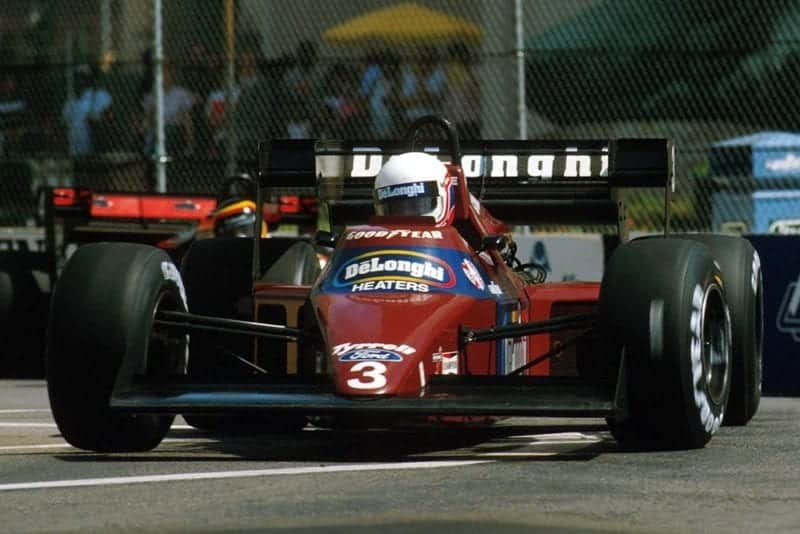
Tyrrell’s Martin Brundle was 11th on the grid
Motorsport Images
Piquet led every lap at Detroit from pole position, but there are two very interesting facts that make his performance all the more remarkable. His pole position lap was achieved on the second of a two lap run in final qualifying on Saturday afternoon. At the wheel of his “qualifying sprint car”, the team spare, Piquet scorched round to grasp pole position, first in 1 min 41.290 sec and, on his second lap, in 1 min 40.980 sec. Not only was this more than four seconds faster than the best Friday time, established by Nigel Mansell’s Lotus 95T, but it might well have been even quicker had the Brabham not lapsed onto three cylinders a couple of corners before the end of the lap. “We couldn’t quite believe it,” smiled Brabham designer Gordon Murray, “because when Nelson came into view coming up to the chicane before the pits, we could hear that the engine sounded sick, so we thought we might have lost the quick lap. It had dropped a valve, in fact, so he was lucky to scrape across the line, let alone set the pole position time!” One is bound to wonder whether Piquet would have broken the 1 min 40 sec barrier if the engine had survived the complete lap intact.
Thus, Nelson was able to line up on pole position, flanked as he had been at Montreal, by Alain Prost’s McLaren MP4/2. On the inside of the second row sat Nigel Mansell’s Lotus 95T, the English driver having again proved remarkably adept during practice on this somewhat acrobatic circuit, and alongside the Lotus sat Michele Alboreto, his Ferrari 126C4 again sporting the electronic Marelli / Weber fuel injection system which has been progressively developed during the course of the season but which hasn’t been raced since Kyalami.
Race
When the starting signal was given, Mansell made a superb, over-prompt getaway, and tried to poke his Lotus through the gap between the Brabham and McLaren ahead of him. Unfortunately, as he manhandled his machine across to the right, the Lotus began to fishtail, striking Prost’s car before bouncing back into the pole position Brabham. Suddenly, Piquet’s car snapped sideways and shot across to the right of the circuit, T-boning Alboreto’s Ferrari against the concrete wall on the opposite side of the circuit. The Italian car came wobbling out of this little fracas with deranged suspension and a broken water radiator, but Piquet’s Brabham moved no further, its rear aerofoil and right rear wheel having been ripped off in the impact. Hardly had the dust settled from this initial impact than Marc Surer’s Arrows-Cosworth (built up round a replacement chassis after Teo Fabi had pushed his original car into the wall during practice!) slammed into the stationary Brabham, jarring Piquet’s neck painfully.
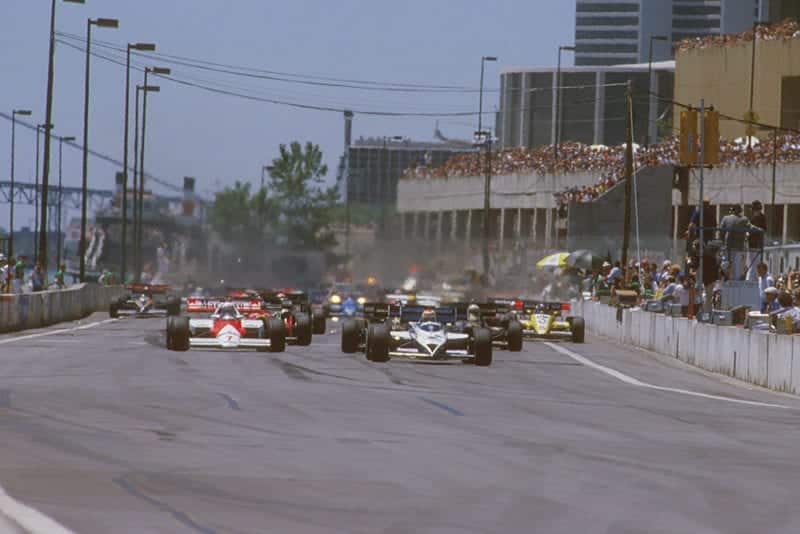
Piquet leads at the restart
Motorsport Images
Wisely, the organisers immediately stopped the race and it was restarted half an hour later. Mansell’s Lotus, amazingly, had survived the skirmish without any damage: just as well, really, because team mate de Angelis had already appropriated the team’s spare car after engine problems in his own during the race morning warm-up session. Alboreto was obliged to take the spare Ferrari, equipped with the old Lucas mechanical injection, Ayrton Senna, whose Toleman had received a nasty smack on its front suspension by the wayward Brabham wheel, also had to take the spare and thus lost out on trying Brian Hart’s new development engine (complete with electronic injection) and, finally, Piquet was also bundled into the Brabham spare for the restart.
It was enormously satisfying for the Brabham team to watch Piquet, who’d received quite a shaking, waltz away with the revived Detroit Grand Prix at the wheel of the spare car, proving that it is possible to virtually duplicate the chassis set-up between two machines. Using the same Michelin tyre choice that was to prove so troublesome on the McLarens, Piquet fended off an early, exploratory challenge from Mansell’s Lotus 95T and after the Englishman initially slowed and then retired with gearbox problems, the Brabham team leader cruised happily home to victory.
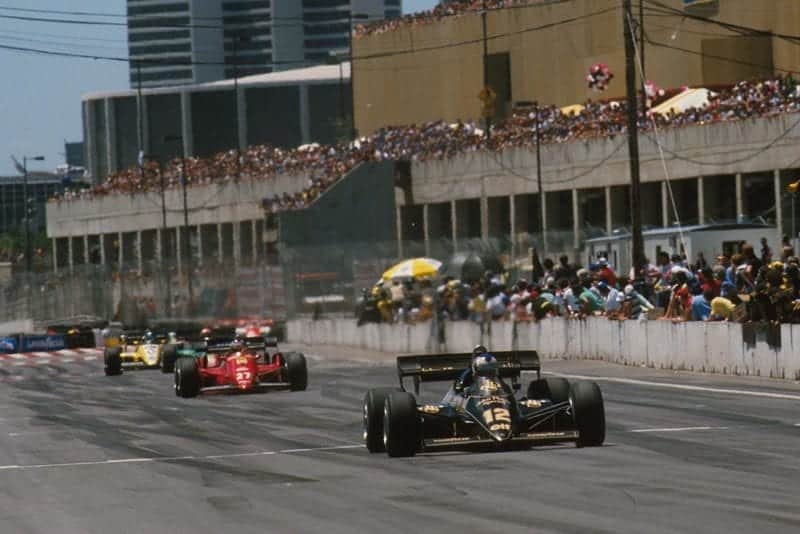
Nigel Mansell ran 2nd until the Lotus gearbox gave up
Motorsport Images
Although Brundle’s performance with the Tyrrell was quite outstanding — he not only managed to finish second despite a routine pit stop for “water ballast” but, even more impressively, qualified in 11th place between Lauda’s McLaren and de Cesaris’s Ligier. For much of the second half of the race the Tyrrell’s engine sounded really sick, but it was only due to a broken exhaust pipe and Martin didn’t find himself unduly handicapped. For many laps his Tyrrell was embroiled in a spectacular midfield scrap which also involved Senna’s Toleman, Bellof in the other Tyrrell and Thierry Boutsen, whose Arrows A7 was showing improved form now that its wheelbase had been slightly lengthened. Brundle was the sole survivor of this group at the finish; Bellof had glanced the chicane before the pits, wiping the left rear corner off his Tyrrell, Senna had crashed at the first corner on his own and Boutson’s BMW engine failed on him. Twelve months ago Michele Alboreto scored what was regarded as a lucky win for Ken Tyrrell at Detroit: Brundle’s second place this time was similarly fortunate, but no less well-earned.
In the McLaren International camp there was an atmosphere of muted confidence prior to the start of the race, but the anticipated threat from Prost and Lauda never materialised. Prost eventually opted to use his spare car on Saturday afternoon after he found the Montreal race engine, about which he had complained the previous weekend, was still installed in his race car. Lauda found his Friday second fastest time disallowed when post-practice scrutineering revealed the rear aerofoil on his McLaren to be one millimetre too wide. “Heat distortion” was officially blamed by the team for this unintentional infraction of the rules, but it didn’t matter at the end of the day (fortunately!) because the Austrian managed to qualify comfortably the following day on 1 min. 43.484 sec. In the race both McLarens “lost grip” early on and Prost made an early stop for fresh rubber on lap 16 — perhaps a little hastily, as events would subsequently suggest.
He was then obliged to make a second stop for tyres after a deflating rear Michelin pitched him into a quick spin: fifth after two pit stops? He might well have been second if he hadn’t made that initial decision to come in! Lauda was similarly handicapped, but his race eventually ended after he had come in to investigate a misfire and, after the plugs were changed, a further exploratory lap suggested that something was about to break inside the Porsche-built engine. He took the prudent route and withdrew before an expensive engine failure ensued.
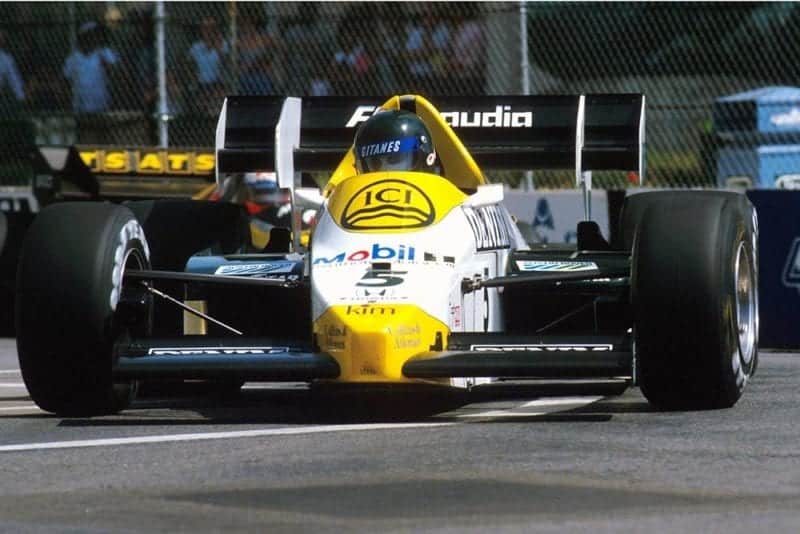
Williams’ Jacques Laffite rose from 19th at the start to 5th at the finish
Motorsport Images
Elio de Angelis’s consistency earned him a third place which might have been second if his Lotus 95T hadn’t developed gearbox problems, similar gremlins causing the retirement of both Renault RE50s. Derek Warwick concentrated his weekend’s activities on the team spare car after a minor accident during the first untimed session on Friday which badly damaged the front end of his race car and saw a front wishbone penetrate the footwell (again!) to bruise Derek’s legs. Nonetheless he qualified sixth and, after an initial stop to change onto harder Michelin rubber, performed splendidly in the race to climb back from 16th on lap 15 to third on lap 32, setting the fastest race lap in the process. Then fifth gear broke and, soon afterwards, the gearbox packed up altogether. With Tambay suffering a similar affliction, it has to be said that the Renault Elf team doesn’t seem to be making a great deal of forward progress. When Warwick first tested for Renault, at Imola last autumn, he made the comment that something had to be done to improve the car’s gearbox. . . .
Fine performances were also produced by Cheever, Alboreto and Rosberg. The relatively short, 157-mile Detroit race meant that the Alfa Romeo drivers for once didn’t have to keep their fingers crossed about the fuel consumption capabilities of their thirsty V8 engines and Cheever really got into the swing of things beautifully. In the early stages of the race he climbed as high as third, ahead of Alboreto, before a split turbo intercooler spelt the beginning of the end for his game efforts. Alboreto had his spare Ferrari up to third before engine failure, prompted again by a leaking intercooler, ended his chances on lap 49, and Rosberg had climbed from an embarrassing 21st position on the starting grid to fourth before his Honda engine overheated and also cried “enough”. The Williams FW09 cars had an absolutely frightful time at Detroit, largely because the chassis are flexing quite dramatically and no amount of minor suspension adjustments seems to be able to sort the problem out. Laffite simply existed at the tail of the field, by contrast, driving round in totally uninspired fashion — ending up a surprised sixth and last when the chequered flag was finally shown!
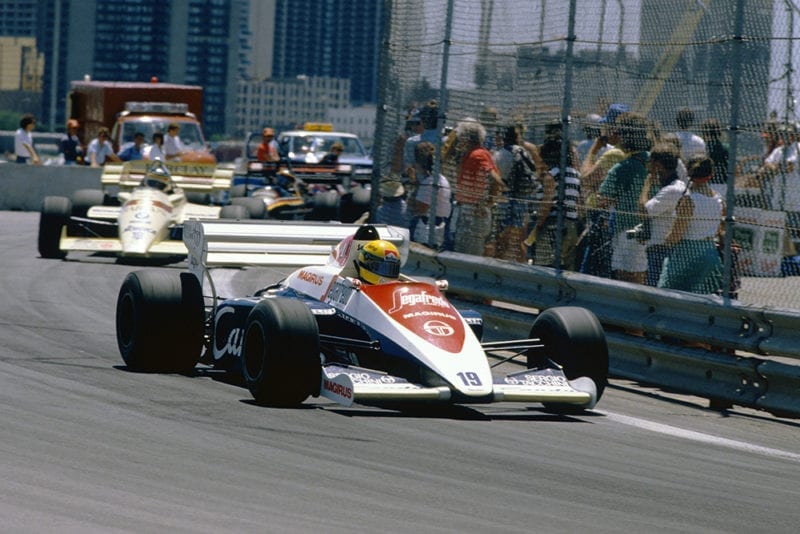
Ayrton Senna crashed out when his Toleman’s right-rear wheel became detached
Motorsport Images
In fourth place, as much to his own surprise as to most observers’, was the diminutive Teo Fabi at the wheel of the second Brabham BT53. The little Italian had another nightmare practice session and frankly admitted that the strain of attempting to dovetail an Indy car racing programme with an intermittent Formula 1 schedule meant that he was doing neither category particularly well. He qualified 23rd, kept his nose clean and wound up with only three cars in front of him at the end of the day, as content with the Brabham-BMW return to reliability as his victorious team-mate!
The Detroit race has been on the international calendar for three seasons now, but although we have seen some fine racing through the streets of this important American industrial city, the organisers do not seem to have learnt a great deal about international racing practice in the meantime. Practice was interrupted by far too many intervals in order to retrieve damaged cars — which should have simply been moved out of the way while qualifying continued and, indeed, would have been at most European circuits. There were insufficient cranes for this purpose, the like of which abound at Monaco, and there was a general atmosphere of tension amidst the organisation which reflected, perhaps, that they didn’t fully understand the ways of European-style Formula 1. Perhaps things will improve in the future — they certainly have time to do so, because Mr Ecclestone tells us that the Detroit Grand Prix will be taking place regularly for the next five years. — A.H.
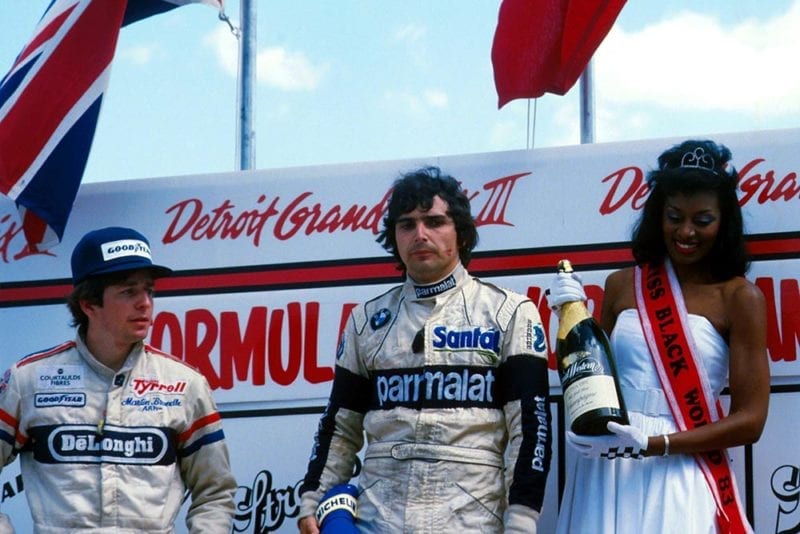
Winner Nelson Piquet (centre) and Martin Brundle celebrate on the podium
Motorsport Images
Results
Detroit Grand Prix III- Formula One — 63 laps — Detroit City — 4.023 kilometres per lap 253.449 kilometres — Warm and Dry
1st : Nelson Piquet ……………………….(Brabham BT53/3) (T) ………………..1 hr 55 min 41.842 sec– 131.449 kph
2nd : Martin Brundle …………………….(Tyrrell 012 /2) …………………………1 hr 55 min 42.679 sec
3rd : Elio de Angelis ………………………(Lotus 95T/ 4) (T) ………………………1 hr 56 min 14.480 sec
4th :Teo Fabi ………………………………(Brabham BT53/2) ……………………..1 hr 57 min 08.370 sec
5th : Alain Prost ……………………………(McLaren MP4/2-3) (T) ………………1 hr 57 min 37.100 sec
6th : Jacques Laffite ………………………(Williams FW09/3) ……………………1 lap behind
7th : Michele Alboreto …………………..(Ferrari 126C4/074)(T) ………………retired on lap 50 — engine failure
8th : Keijo Rosberg ………………………..(Williams FW09/6) (T) ……………….retired on lap 48 — turbo failure
9th : Derek Warwick ………………………(Renault RE50/03) (T) ………………..retired on lap 41 — gearbox failure
10th : Stefan Bellof ………………………..(Tyrrell 012/1) (T) ……………………..retired on lap 3 4 — crashed
11th : Patrick Tambay …………………….(Renault RE50/07) …………………….retired on lap 34 — gearbox failure
12th : Philippe Alliot ………………………(RAM 02/01) …………………………….retired on lap 34 — crashed
13th : Niki Lauda ……………………………(McLaren MP4/2-1) …………………..retired on lap 34 –engine failure
14th : Nigel Mansell ……………………….(Lotus 95T /2) …………………………..retired on lap 28 — gearbox failure
15th : Thierry Boutsen ……………………(Arrows A7/2) …………………………..retired on lap 28 — engine failure
16th : Andrea de Cesaris …………………(Ligier JS23/4) …………………………..retired on lap 25 — suspension failure
17th : Johnny Cecotto …………………….(Toleman TG184/03) …………………retired on lap 24 — clutch trouble
18th : Eddie Cheever ……………………..(Alfa Romeo 184T/02) ……………….retired on lap 22 — turbo failure
19th : Ayrton Senna ………………………..(Toleman TG184/01) (T) …………….retired on lap 22 — crashed
20th : Riccardo Patrese ……………………(Alfa Romeo 184T/01) ……………….retired on lap 21 — driver gave up
21st : Francois Hesnault …………………..(Ligier JS23/2) …………………………..retired on lap 4 — collision damage
22nd : Piercarlo Ghinzani …………………(Osella FA 1F-02) ………………………retired on lap 4 — collision damage
23rd : Rene Arnoux …………………………(Ferrari 126C4/075) …………………..retired on lap 3 — suspension failure
24th : Jonathan Palmer ……………………(RAM 02/02) …………………………….retired on lap 3 — crashed
25th : Manfred Winkelhock ……………..(ATS D7/01) ……………………………..retired on lap 1 — engine failure
26th : Marc Surer ……………………………(Arrows A6/2) …………………………..eliminated in first start-line accident
Fastest lap: Derek Warwick (Renault RE50/03) on lap 32 in 1 min 46.221 sec — 136.358 kph
25 starters — 6 finishers
